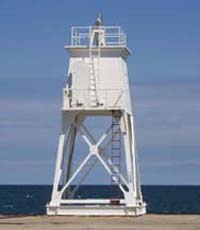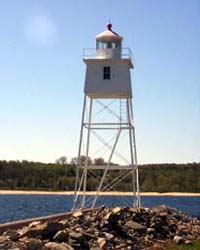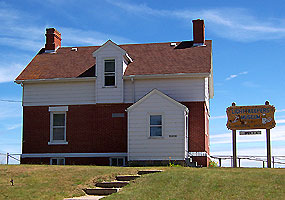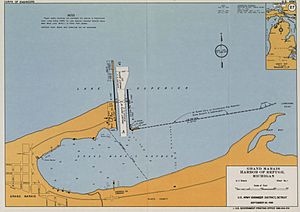Grand Marais Harbor of Refuge Inner and Outer Lights facts for kids
 |
|
| Outer range light | |
|
|
|
| Location | West pier at entry to Grand Marais Harbor of Refuge, Grand Marais, Michigan |
|---|---|
| Coordinates | 46°41′2″N 85°58′20″W / 46.68389°N 85.97222°W |
| Year first constructed | 1895 |
| Year first lit | 1895 |
| Foundation | concrete pier |
| Construction | steel (outer) and cast iron (inner) |
| Tower shape | skeletal |
| Height | 55 feet (17 m) (inner) and 34 feet (10 m) (outer) |
| Focal height | 53 feet (16 m) (inner), 40 feet (12 m) (outer) |
| Original lens | Fifth order Fresnel lens(inner) |
| Current lens | Fifth order Fresnel lens(inner), modern acrylic lens (outer) |
| Range | 14 nautical miles; 26 kilometres (16 mi) (inner),7.8 nautical miles; 14 kilometres (9 mi) (outer) |
| Characteristic | F W (inner), FI W 2.5s (outer) |
| ARLHS number | USA-1079, USA-1080 |
| USCG number | 7-14560 (inner), 7-14550 (outer) |
The Grand Marais Harbor of Refuge Inner and Outer Lights are two important lighthouses in Grand Marais, Michigan. You can find them on the west pier, right at the entrance to the Grand Marais Harbor. These special lights were added to the National Register of Historic Places in 2012 because of their historical importance.
Building the Harbor and Lights
In the 1870s, many more ships started traveling across Lake Superior. People realized there wasn't a safe place for ships to stop between Whitefish Bay and Grand Island.
So, in 1881, the Army Corps of Engineers began to improve the harbor at Grand Marais. The Army Corps is a group that builds things like harbors and waterways for the country.
Over the next ten years, they worked hard. They made the harbor deeper by "dredging" it, which means digging out the bottom. They also built a long timber wall, about 5,770 feet (1,760 m) across the harbor. This wall was called a breakwater, and it helped protect the harbor from big waves.
They also dug a shipping channel into the harbor. Then, they built two long wooden piers, each about 700 feet (210 m) long, on either side of this channel. These piers were built section by section.
As the harbor work finished, the Lighthouse Board decided that a light and fog signal would help ships find their way. The Lighthouse Board was the group in charge of building and maintaining lighthouses.
They asked for money in 1892, and Congress gave them the funds in 1895. The Board quickly planned and built a ready-made light tower. This new light was ready by November 1895.
A fog signal from the Point Iroquois Light was moved to Grand Marais. No house was built for the lighthouse keeper at first, so the project cost less money. The keeper had to live in a temporary shack.
The Lighthouse Board then realized that adding a second light, called a "rear range light," would make navigation even better. A range light helps ships line up correctly to enter a harbor.
Congress agreed in 1897 to use the extra money for this second light. By 1898, the second light was built and put at the inner end of the pier.
Changes Over Time
In 1905, the west pier was made longer by 612 feet (187 m). The next year, the front range light was moved to the end of this new pier. Finally, in 1908, a proper house for the lighthouse keeper was built.
As bigger ships started using the Great Lakes, the Grand Marais harbor became less important. In the 1940s, the Army Corps of Engineers stopped taking care of the breakwater. It soon rotted away, and sand began to fill the harbor.
Around this time, the Coast Guard took over running the lights. The Coast Guard is a part of the military that protects our waters and helps with things like navigation.
In the 1960s and 70s, parts of the pier where the lights stood were covered with concrete. Also, the west pier was made even longer by 802 feet (244 m) with a new type of extension.
Lighthouse keepers lived in the keeper's house until 1982. In 1984, the Grand Marais Historical Society took over the house and fixed it up. Now, it's a museum!
Both lighthouses are still working today. The outer light has a modern plastic lens. But the inner light still uses its original Fresnel lens. A Fresnel lens is a special type of lens that makes the light much brighter and can be seen from far away. It's one of the few original Fresnel lenses still used in lighthouses!
What the Lights Look Like
The Grand Marais Harbor Inner and Outer lights are two lighthouses on the Grand Marais pier. They are about 2,610 feet (800 m) apart.
Both lights are made of iron or steel frames, painted white. They are bolted to the pier. The outer light is 34 feet (10 m) tall, and the inner light is taller at 55 feet (17 m).





